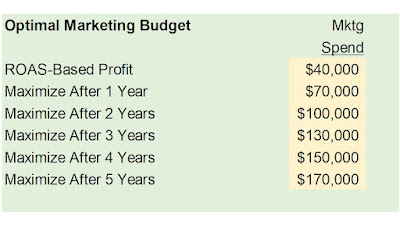Yesterday, we established the fact that ROAS is related to Profit per Customer/Order. The two metrics are directly related ... Profit per Customer/Order is directly actionable.
What makes this stuff fun is the balance between how much money you lose within campaigns (yes, you notice I said "lose" ... gonna be a controversial take going forward) and how much money you make thereafter. There is a balance, and it takes some sophisticated math to evaluate the balance. Fortunately, I have thousands of lines of computer code to perform the math required to evaluate the relationship.
In the scenario below (and this graph is important), we plot the relationship between how much we spend within marketing campaigns and how much long-term profit we generate. Each curve represents a payback window. If our payback window requires us to execute a profitable campaign, we can spend a small amount of marketing dollars. If our payback window allows us to make the most profit over time, we can spend a lot of marketing dollars. A lot!
Here's the relationship.
The arrows are important here. The arrows tell us how much to spend on marketing to achieve optimal profit. Each curve represents a different payback window.
If you need a lot of profit today, you spend a small amount on marketing.
If you want a lot of profit tomorrow, you spend a lot of money on marketing.
If you are unhappy with the size of your business today, it's the cumulative impact of many years of trying to optimize short-term profit that leaves you with too little profit today.
The optimal levels of profit above are illustrated in the table below.
ROAS-centric marketing requires a small amount of marketing spend to optimize campaigns right now. If your ROAS is high, you made sure you delivered profit today.
But if long-term value is sufficient (and in this case long-term value is sufficient - see below)?
If you generate $46 of profit over five years, you might be willing to lose $30 per customer/order within a marketing campaign (which yields an amazingly low ROAS) because the long-term health of your business is assured.
I created an algorithm ... thousands of lines of computer code. The algorithm tells the secrets to marketing investment for your company. Based on how much your customers pay you back and based on how sharp the law of diminishing returns is for your brand, your future is determined by the decisions you make today. Said differently ... if you aren't happy with today, it is quite likely you didn't invest properly over the past five years.
As I mentioned on Friday, you can jump in on the development stage of the algorithm through this weekend at approximately 40% off (click here for the full price). By Monday, it's full price, and based on the feedback I received over the past eight days, it's gonna be a busy period!
And it's gonna be ... SO ... MUCH ... FUN ... to learn how short-term marketing investments relate to long-term business health.





No comments:
Post a Comment
Note: Only a member of this blog may post a comment.